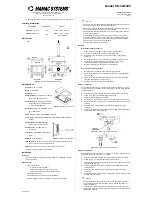
Measurement Specialties
KPSI
®
Digital Series User’s Manual
Page 12
www.Meas-Spec.com
If the field calibration offset is non-zero, then one of the following values of “u” will be returned:
10
units are feet of water with non-zero field calibration offset
11
units are psi with non-zero field calibration offset
12
units are kilopascal with non-zero field calibration offset
13
units are cm of water with non-zero field calibration offset
14
units are meters of water with non-zero field calibration offset
15
units are mm of water with non-zero field calibration offset
19
user units with non-zero field calibration offset
(psi + field calibration offset) * user slope + user offset
set by XE or XS
set by XUU set by XUU
If the unit has had its calibration modified at a standards lab other than at Measurement
Specialties, then the value returned for “u” will have one hundred (100) added to it. In other
words, if the “
XC
” command has been utilized to set the calibration scale factor
(slope)
to other
than 1 or the calibration
offset
factor to other than 0, then 100 will be added to the unit’s
indicator.
Starting a Concurrent Measurement (C[v] command)
The command to tell the sensor to start a concurrent measurement is:
aC[v]!
Where “a” is the
address
character, and “C[v]” is a
Start Concurrent Measurement
command. An optional digit “v” identifies command
variations
.
In reply, the sensor will respond with:
atttnn
Acknowledges it is from sensor with
address
“a”, that “ttt” seconds are required
before the measurement is completed, and “nn” values will appear in final data
stream acquired. Note the 2-digit “nn” returned allows for a larger number of data
items to be returned in the eventual data response (though not utilized by model 500
sensor).
When the measurement is complete, the sensor does NOT issue the second response, known
as a
Service Request
response, as did an
“M”
command. To request the data you must enter
the
Get Data
command only after the first response’s
estimated time for completion
(ttt) has
expired:
aD0!
Where “a” is the address character and “
D0
” is the command to retrieve measured
data. Note: the
number zero
follows D,
not
the
letter
“O”.
As in all of the other (non-CRC) “M” and “C” commands, a
“D0”
command must eventually be
issued to get the data from the sensor. In its response, three data measurements and a CRC
appendage are returned as follows:
a+3.14+2.718+1.414Ipz
where (“
Ipz”
) is the three-character CRC code appendage.














































